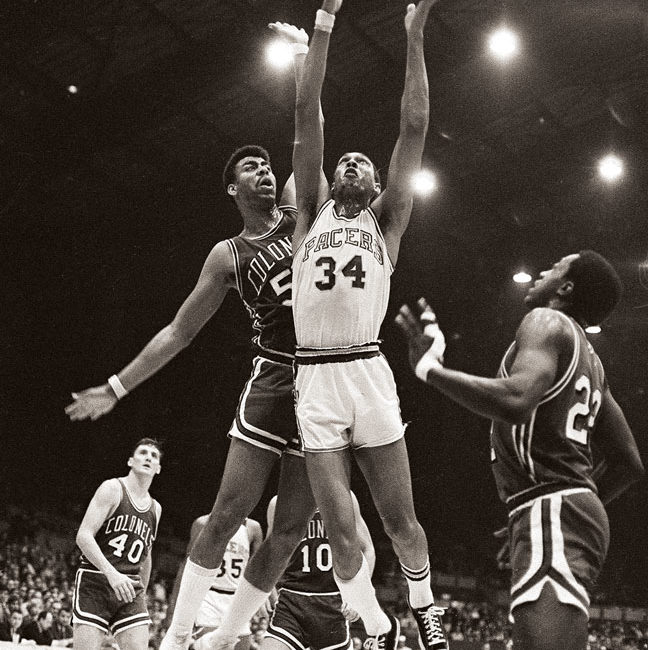
Speed Read: Dunk History
Kids, there wasn’t always such a thing as a three-point shot in pro basketball. The ABA revolutionized professional basketball, popularizing stars like Julius Erving, emphasizing a loose and speedy style of play, and introducing the now-beloved trey. During it all, the Indiana Pacers—one of the league’s 10 charter teams— were right at the center.
The ball. That’s what most people remember when they think of the ABA. But the league’s signature sphere—not brownish-orange but red, white, and blue—was only part of what made it special. The ABA formed in 1967 and quickly separated itself from the stodgy NBA. Some of the differences were good, or at least popular. (The league sponsored a flashy dunk contest at a time when college basketball had actually banned rim-rocking finishes; it also innovated in the use of skimpily clad cheerleaders.) But the ABA also struggled with small crowds, forgettable franchises, and run-down arenas, even as it offered a stylish and high-scoring brand of basketball.
The ABA gave us the Pacers. “None of us had any idea what we were doing,” the team’s original owner, Dick Tinkham, says in Loose Balls, a rollicking oral history of the ABA. “Our idea was that Indiana was great basketball country, and we had a chance to be the only show in town if we could win.” Initially, the Pacers played at the Indiana State Fairgrounds. Still, Tinkham and his colleagues worked hard to make sure their team became ABA royalty, eventually winning three championships. When the league merged with the NBA in 1976, the Pacers were one of four teams to make the jump—along with a number of high-flying ABA stars.
One of those hotshots: George “The Iceman” Gervin. During his ABA days, Gervin and the San Antonio Spurs traveled to Indianapolis, where the Pacers held a special promotion: If the home team could hold Gervin to 30 points or fewer, every Hoosier in attendance would get free chicken. The possibility of poultry revved up the crowd—until Gervin dropped 25 points in the first half. As he walked into the locker room, he hollered at the fans sitting courtside: “No chicken tonight!” Gervin finished the game with 55. He’s scheduled to appear at this month’s reunion, along with other ABA alums like Pacers greats George McGinnis and Slick Leonard.
Dr. J. Yeah, he’s going to be there, too.
It’s all for a good cause. The reunion was organized by the Dropping Dimes Foundation, an Indy nonprofit that funnels money and healthcare assistance to ex-ABA players, coaches, and staffers in need. A league that was barely solvent in its best years didn’t leave much in the way of a pension plan. That’s where Dropping Dimes, whose advisory board includes Myles Turner and Reggie Miller, steps in with the assist.
Bob Costas is playing emcee. The reunion event features a dinner with the ex-players, then a Q&A session moderated by Costas. (He got his break in the ABA, too, doing radio play-by-play for the St. Louis franchise.) You can buy tickets online at droppingdimes.org. There will also be an autograph session at the Fieldhouse open to the general public.
The league’s legacy is worth a toast. The ABA and the Pacers have meant a lot to Indianapolis. After all, nearly two decades before the Colts came to town, the Pacers staked their claim and established this as a real, big-league city. The ABA made an even bigger impact on the sport of basketball. Our fast and fun NBA (Oladipo from deep!) owes a lot to the ABA’s example. Before today’s pros ran up and down the floor, benching their big men for springy forwards, chucking threes, and dunking with pizzazz . . . well, yesterday’s pros were doing the same thing, exactly 50 years ago. The only real difference? They did it in red, white, and blue.





